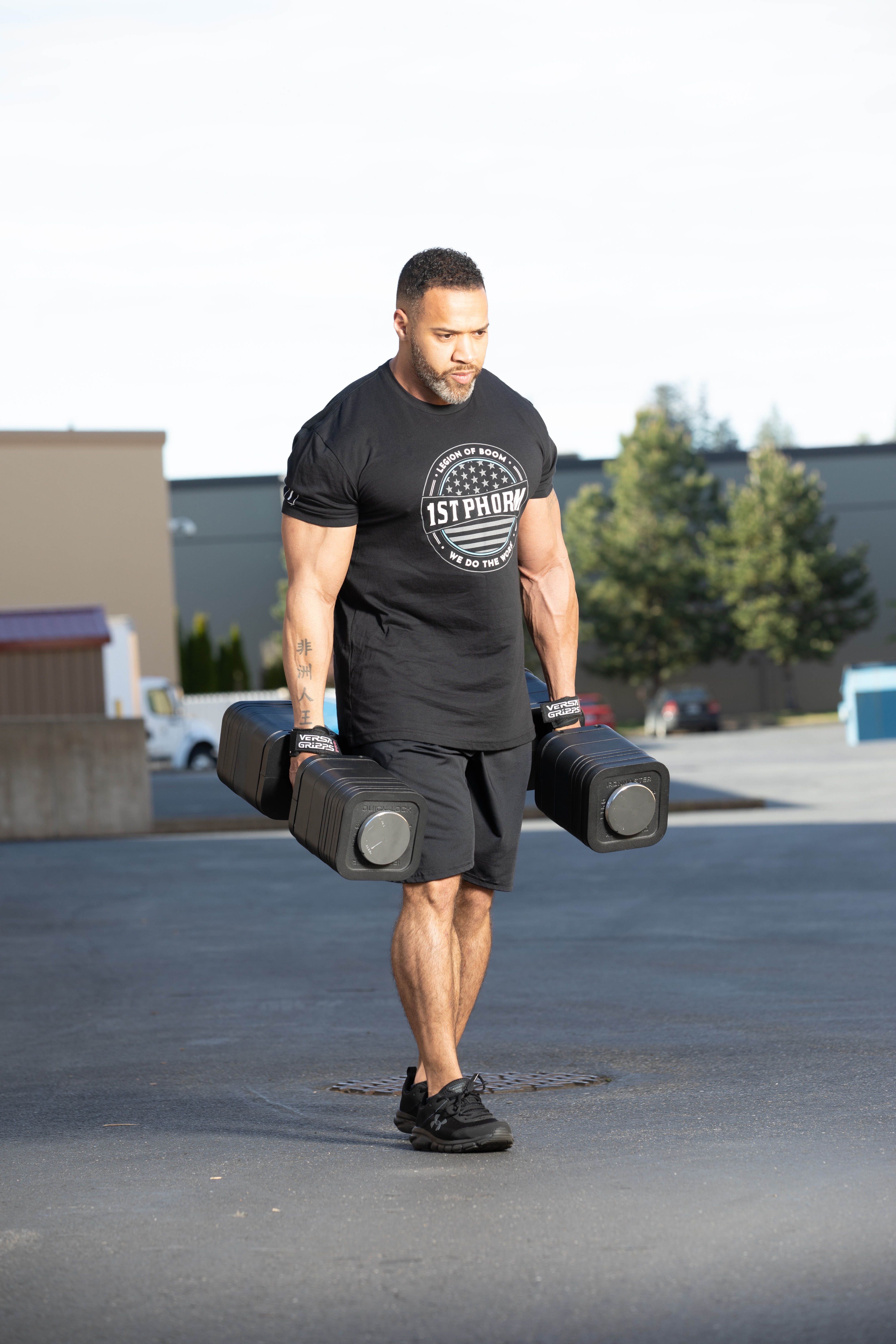By Andre Adams
With any training regimen the body is always in a state of adaptation. To continuously improve performance over time, your training must be modified to increase the acute variables and progressively overload the muscles.
In this blog we will look beyond the pseudoscience and dive into the underlying scientific principles behind progressively overloading the neuromuscular system, and the potential benefits with respect to resistance training and muscle development.
For fitness enthusiasts, NASM-CPTs, Corrective Exercise Professionals, and more, this topic is important to master.
WHAT IS PROGRESSIVE OVERLOAD?
The Principle of Progression states that increases in time, weight or intensity should be kept within 10% or less each week to allow for a gradual adaptation while minimizing risk of injury. Without this progressive overloading, muscle growth will plateau
A decrease in loading over an extended period can actually cause muscle atrophy – a loss in skeletal muscle size and strength. With consistent training the body will adapt to the progressions and meet the demands of the stress placed upon it.
| The National Academy of Sports Medicine (2018) defines Hypertrophy as “the enlargement of skeletal muscle fibers in response to being recruited to develop increased levels of tension, as seen in resistance training. [It] is characterized by an increase in the cross-sectional area of individual muscle fibers resulting from an increase in myofibril proteins (myofilaments). |
WHY DO YOU NEED TO PROGRESSIVELY OVERLOAD?
As the body adapts to the current resistance training program, the client will notice the same sets and reps are no longer difficult to complete. There are several levers the trainer can pull such as increasing the repetitions, intensity, timing, distance, or introducing a variety of movements to increase the demand on the muscles. One of the most common and effective ways to challenge the client and avoid plateau is to increase the load of the resistance training.
Initially, if a client performed a movement for 3 sets of 12 repetitions, but now performs 15-20 repetitions, an appropriate action might be to increase the weight by 5-10% until the client can only perform 8-12 reps with good form to keep them in the Hypertrophy phase. Force and repetitions are valuable indicators for the trainer to gauge when to progressively overload.
HOW DOES OVERLOAD WORK IN FITNESS?
3 mechanisms of building muscle through strength Hypertrophy are metabolic damage, muscle-tension (force), and exercise induced muscle damage. With respect to progressive overloading, you are effectively attacking the muscle-tension variable by increasing the load and causing an adaptation in force output of the muscle over time.
This additional stress placed upon the muscles will force the client to work harder and recruit as much muscle fiber as possible to complete the exercise. It is imperative to observe client form and intensity in order to know when it is appropriate to increase the force.
Check out the NASM Guide to Bodybuilding for relevant info to complement this principle.
PERIODIZATION AND PROGRAMMING
Periodization and programming will drive progressive overload by working through different phases of the OPT model, and incorporating progressive exercises, weights and intensity into the plan. Progressions can be incorporated on a macro, meso, or micro cycle basis.
Periodization forces some progressive overloading as you continuously work through more challenging phases. However, it is not uncommon to progressively overload the demand on the client within a single workout. The best way to fully understand exactly when it is time to increase loading is by observing the client during training. For progressively overloading weights, observe the level of effort exhibited by the client while performing each set. Additionally, using visual and client feedback allows the trainer to choose a more appropriate weight.
It is not uncommon to increase loading every few weeks as the client’s body adapts to the training intensity and exercise. Another variable for the trainer to modify adding additional working sets.
By increasing working set volume from 3, to 4 or 5 sets over time you can challenge the client’s strength endurance in addition to Hypertrophy. For instance, by set 4 the client may no longer be able to perform excess reps beyond 8-12, keeping them more within the Strength Hypertrophy range.
PYRAMID SETS, DROP SETS, PARTIALS AND NEGATIVES
Other effective tools used in athletic training, such as bodybuilding and powerlifting, are pyramid sets, drop sets, super sets, partials, and negatives.
PYRAMID SETS
This technique involves incrementally increasing the weight for each working set. In most cases the number of repetitions will drop as the load increases. For example, a set of 4 bench presses might be:
- 135 lbs x 12,
- 150 lbs x 10,
- 165 lbs x 8, and
- 180 lbs x 6.
The goal is to slowly increase the load to avoid injury and recruit both slow and fast-twitch muscle fiber as you work towards your top set.
DROP SETS: ALSO KNOWN AS THE STRIPPING METHOD
Drop sets are an effective means good tool to overload the body on volume and increase Hypertrophy.
Typically, Drop Sets are used as a finisher after most working sets are complete. A heavy weight is used at the start of this technique with the trainer helping to decrease the load after each successive set. It is important to note this training method should be performed with little to not rest between each working set. This progressively overloads the muscle and cardiorespiratory system. I.e.
QUAD EXTENSIONS DROP SET:
- Set 1 is 100 lbs x 5
- Set 2 is 80 lbs x 6
- Set 3 is 60 lbs x8
- Set 4 is 40 lbs x 10.
- Completed in back-to-back fashion with 0-10 sec rest between sets.
SUPER SETS
Super Sets are one of the most common techniques used in bodybuilding and advanced resistance training programs. Super Sets involve pairing two or more exercises together back-to-back. These could be complimentary, adjacent, or unrelated muscle groups.
When training complementary or adjacent muscle groups it helps maximize the Hypertrophy/pump by maximizing blood flow into those muscles. There is also a synergistic effect of alternating the agonist and antagonist muscles being trained, and it’s a great way to make more efficient use of your time in the gym. Good examples are Super Setting biceps and triceps, chest and back, or quads and hamstrings.
PERIPHERAL HEART ACTION TRAINING
Another Super Set technique that can drive progressive overloading is training an upper and lower body exercise to force peripheral heart action. This challenges the cardiorespiratory system differently and will force this system to adapt to the increase in intensity over time.
An example is performing an overhead shoulder press, and then a set of prisoner squats.
PARTIALS
Partial reps are primarily used in maximal strength training programs, such as powerlifting when training for a personal record (PR). This forces an adaptation by overloading muscle tension with 90-110% of 1 rep max and is performed by only moving through a partial range of motion (ROM).
This technique requires a spotter(s) to ensure proper form and safety is used. In an 8-week training program the goal is to increase force output of the movement through physiological adaptions and stronger neuro-muscular control due to greater demand placed on the muscles.
NEGATIVES
Negatives – Similar to Partial reps, except the progression is created by using greater than 100% 1 rep max (with spotter) on the eccentric movement of the lift, with assistance on the concentric portion. This technique works through a full ROM in which the client will resist the heavier load on the way down.
*These techniques are most used in the strength Hypertrophy and maximal strength phases.
WHO SHOULD OVERLOAD?
Anyone who is working out should go through some form of progressions over time. This doesn’t necessarily mean adding a ton of weight to each exercise, but the trainer should have a strategy for progressing the client to avoid plateaus. The demand on the neuromuscular systems should be continuously challenged over time to create the necessary adaptations.
Depending on the meso/macro periodization, this cycle may include a de-loading phase to allow the client to fully recover (or overcome an injury or over-training) before progressing through the OPT model phases again.
WHEN SHOULD YOU PROGRESSIVELY OVERLOAD?
Each client’s needs will vary based on training regimen, genetics, nutrition, and many other factors. It is also dependent upon client goals (I.e. weight loss vs increasing muscle). The most common periodization would schedule in progressions every 2-4 weeks. However, there are times when client needs may call for progressive overloading weekly or within a single workout.
HOW LONG SHOULD YOU DO IT, AND IS OVERLOADING NECESSARY?
Progressions are a continuum that is regulated based on client performance, injury avoidance and goals. Making adjustments should occur based on client progress. Overloading is not necessary to work out, but plays an essential role in creating the adaptations desired for improving performance over time.
WHAT ARE THE BENEFITS OF OVERLOADING?
Some lesser known benefits of progressive overloading in resistance training include physiological, physical, and performance adaptations:
General Adaptation Syndrome
* Optimal state of human movement system is one of physiologic balance or homeostasis.
* General Adaptation Syndrome – Used to describe how the body responds and adapts to stress. For adaptations to occur, the body must be confronted with a stressor of some form that creates the need for a response.
* Three stages of response to stress: alarm reaction, resistance development, exhaustion

ANY CONS?
– Must be sensitive to avoid counterproductively affecting corrective exercise protocol (CES)
– Must be able to find creative ways to progressively overload different variables to avoid using too much weight over time if it puts the client at risk for injury. Other variables to overload besides weightare duration, intensity, rest intervals, distance, volume, etc.
THE AUTHOR

ANDRE ADAMS
Andre Adams is a professional athlete with the International Federation of Bodybuilding (IFBB) pro league, having competed in the 2015 Mr. Olympia and Arnold Classic professional physique divisions. He is also a master trainer with the National Academy of Sports Medicine® (NASM), physique contest prep coach, and holds several specializations with NASM. Certifications include: NASM-CPT, WFS, PES, WLS, GPTS, FNS and MT.

